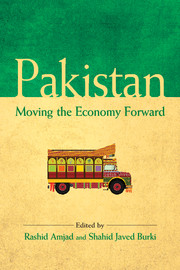Book contents
- Frontmatter
- Contents
- List of figures and tables
- Preface
- 1 Overview
- 2 Failed Economic Promise: Lessons from Pakistan's Development Experience
- 3 Economic Management Under IMF Tutelage: Key Lessons from the Musharraf and PPP Rule 1999–2013
- 4 A Country and an Economy in Transition
- 5 Tackling the Energy Crisis
- 6 Exports: Lessons from the Past and the Way Forward
- 7 The Future Path of Tax Reforms in Pakistan
- 8 Pakistan's Indus Basin Water Strategy: Past, Present and Future
- 9 Economic Governance and Institutional Reforms
- 10 Benefiting from Foreign Direct Investment
- 11 An Analysis of the Remittances Market in Pakistan
- 12 The Prospects for Indo-Pakistan Trade
- 13 Beyond the Poverty Line: A Multidimensional Analysis of Poverty in Pakistan
- 14 Can the New Intergovernmental Structure Work in Pakistan? Learning from China
- Contributors
- Index
6 - Exports: Lessons from the Past and the Way Forward
Published online by Cambridge University Press: 05 May 2015
- Frontmatter
- Contents
- List of figures and tables
- Preface
- 1 Overview
- 2 Failed Economic Promise: Lessons from Pakistan's Development Experience
- 3 Economic Management Under IMF Tutelage: Key Lessons from the Musharraf and PPP Rule 1999–2013
- 4 A Country and an Economy in Transition
- 5 Tackling the Energy Crisis
- 6 Exports: Lessons from the Past and the Way Forward
- 7 The Future Path of Tax Reforms in Pakistan
- 8 Pakistan's Indus Basin Water Strategy: Past, Present and Future
- 9 Economic Governance and Institutional Reforms
- 10 Benefiting from Foreign Direct Investment
- 11 An Analysis of the Remittances Market in Pakistan
- 12 The Prospects for Indo-Pakistan Trade
- 13 Beyond the Poverty Line: A Multidimensional Analysis of Poverty in Pakistan
- 14 Can the New Intergovernmental Structure Work in Pakistan? Learning from China
- Contributors
- Index
Summary
Introduction
The idea that trade is important for economic growth dates back to the nineteenth century when classical economists such as Adam Smith, David Ricardo, and John Stuart Mill advocated the favorable effects of international trade on output. Since then, a rich body of theoretical and empirical literature has evolved with regard to the role of trade in growth and development. Initially, postwar development economists viewed trade as a negative factor in developing countries' industrialization objectives, and from the 1950s through the early 1970s most newly independent countries adopted an import-substitution industrialization (ISI) strategy. By the mid-1970s, however, there was growing disenchantment among development economists concerning ISI in favor of the export-led growth strategy that several East Asian countries had successfully adopted. Subsequently, this was formalized in what is referred to as the “Washington consensus”: generally described as an outward-oriented development (OOD) strategy, it has since been adopted by most developing countries.
According to proponents of the OOD strategy, outward orientation can promote economic growth through three main channels. The first is trade, which enables firms (at the micro-level) and countries (at the macro-level) to gain through specialization and economies of scale. This is because increased competition results in the least efficient producers being driven out of the market while the most efficient producers expand their market share, thus raising aggregate productivity through the reallocation of resources (Tyler, 1981; Melitz, 2003). The second is exports, which serve as the primary source of foreign exchange needed to purchase imported inputs such as raw material and machinery and, more broadly, to help ease the balance-of-payments constraint (Faridi, 2012). The third channel involves trade as an important source of knowledge and technology transfer with the potential to encourage innovative activity—such as research and development, and the introduction of new products and processes—by increasing the returns on innovation as exporters have access to a larger market than nonexporters.
- Type
- Chapter
- Information
- PakistanMoving the Economy Forward, pp. 135 - 170Publisher: Cambridge University PressPrint publication year: 2015
- 1
- Cited by



